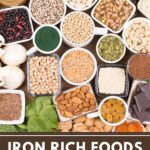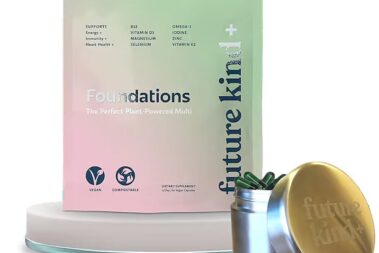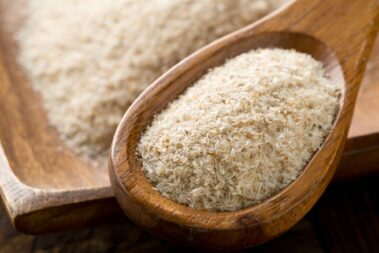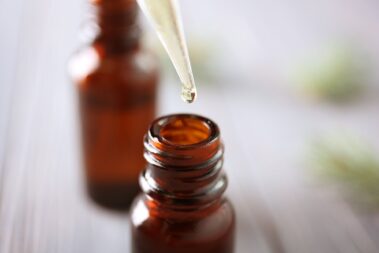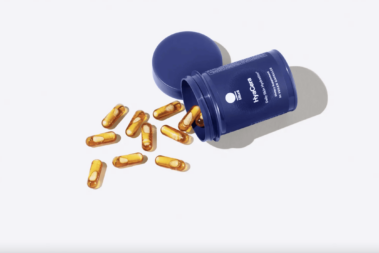Iron is an important mineral that is essential for healthy red blood cell production and the transportation of oxygen throughout your body.
There are two main types of iron: heme and non-heme. Heme iron is found exclusively in animal-based foods such as meat and seafood, whereas non-heme iron is primarily derived from plant sources (1).
Non-heme iron is less bioavailable—or more difficult for the body to absorb—compared to heme iron, thus, people following strict vegan or vegetarian diets may be at an increased risk for developing iron deficiency (1).
Iron deficiency is one of the most common nutrient deficiencies worldwide and is the leading cause of anemia.
Iron deficiency anemia can lead to a variety of adverse physical symptoms including fatigue, weakness, difficulty concentrating, and impaired cognitive and immune function (1).
The best way to prevent low iron levels on a strict plant-based or vegan diet is to make sure you’re consuming plenty of plant-based sources of iron.
The recommended daily amount of iron for those eating a mixed diet is 8mg for men, and 18mg for women.
However, if you follow a vegan or strict vegetarian diet you’ll want to aim for 1.8 times that amount to make up for the reduced bioavailability of iron from non-heme sources. That equates to about 14.4mg for men and 32.4mg for women (1).
This article will review 15 plant-based foods that are high in iron, plus a few tips for improving absorption of iron from plant sources.
Table of Contents
1. Soybeans
Whole soybeans and various foods made from them are a great source of plant-based iron.
A ½ cup serving of edamame provides 15% of the daily value of iron, while 4 ounces of tofu or tempeh each offer about 18% (2, 3, 4).
As an added bonus, soybeans also happen to be one of the few sources of complete, plant-based protein.
2. Lentils
Lentils are another good option for boosting iron intake on a plant-based diet, with just ½ cup providing over 17% of the daily recommendation (5).
Lentils are one of the most antioxidant-rich varieties of legumes and they’re also an excellent source of fiber, which supports healthy digestion and blood sugar balance (6).
Compared to other types of legumes, lentils don’t require much cooking time which makes them a great choice for a quick weeknight meal or meal-prep session.
3. Chickpeas
Chickpeas, also known as garbanzo beans, are among the most versatile sources of plant-based iron.
One cup of cooked chickpeas provides a quarter of your daily iron needs, plus almost 12 grams of fiber and 14 grams of protein (7).
Add whole chickpeas to soups, curries, and salads, or blend them with olive oil and tahini to make hummus. You can also use chickpea flour to add a nutrient boost to homemade baked goods.
4. Black eyed peas
An unsung nutritional hero of sorts, black eyed peas are a great way to squeeze a variety of nutrients into your diet using just one food.
One cup of cooked black eyed peas offers 20% of the daily value of iron along with a host of other vital nutrients including magnesium, potassium, and folate (8).
Black eyed peas are considerably less popular than many other types of legumes, but their obscurity makes them a particularly desirable option for anyone looking to diversify their menu.
5. Whole grains
Most people can come up with at least a handful of reasons why including whole grains in your diet is a good idea, but what many don’t realize that their iron content is one of them.
A one-cup serving of the following whole grain varieties offer 10% or more of the daily recommendation for iron (9, 10, 11, 12, 13, 14, 15):
- Amaranth
- Barley
- Oats
- Quinoa
- Teff
- Spelt
- Black rice
What’s more, in the United States many commercially prepared grain-based foods—such as breads and breakfast cereals—are fortified with iron in order to make it even easier to meet your iron needs.
6. Nuts and Nut Butters
Nuts and nut butters are probably best known for being a good source of heart healthy fats and plant-based protein, but certain types can also help you boost your iron intake.
A two-ounce serving of cashews, pine nuts, pistachios, or macadamia nuts will provide you with 10% or more of your daily iron needs (16, 17, 18, 19).
You can enjoy them whole or ground into butter form, but be mindful to limit your intake of varieties that contain lots of added sugar or salt.
7. Pumpkin Seeds
Not only can eating pumpkin seeds help you maintain your iron status, but it also comes with a side of fiber, antioxidants, healthy fats, and plant-based protein.
Just ¼ cup of shelled pumpkin seeds will get you almost 16% of the way to a full day’s worth of iron. While you’re at it you’ll also be getting about 45% of the daily recommended amount of magnesium (20).
8. Sesame seeds (and tahini)
If you thought sesame seeds were only good for topping burger buns—think again.
A one-ounce serving of whole sesame seeds offers 12% of the daily value of iron in addition to considerable amounts of zinc, selenium, and copper (21).
Tahini is a type of spread made from sesame seeds—think peanut butter, except replace the peanuts with sesame seeds. It contains about 7% of the daily value of iron in each tablespoon and has recently been gaining lots of attention for its versatility in the kitchen (22).
You can use tahini as a base for savory salad dressings, sauces, and dips, or it can be added to desserts to impart a richer flavor and creamy texture.
9. Dried fruit
Certain types of dried fruit may be used to help you get closer to meeting your iron needs.
A ½ cup of dried currants provides about 13% of the daily value of iron and the same portion of dried apricots offers just under 10% (23, 24).
One cup of prunes and dried apple each contain about 9% and 7%, respectively (25, 26).
Dried fruit also happens to be a convenient, portable way to get more fiber, vitamins, and other essential minerals into your diet. Just try to avoid varieties that contain added sugar.
10. Sun Dried Tomatoes and Tomato Paste
Fresh tomatoes are not a particularly rich source of iron, but when they’re dried or concentrated it’s a completely different story.
A ½ cup serving of sun dried tomatoes contains approximately 13% of a day’s worth of iron and just ¼ cup of tomato paste offers about 8% (27, 28).
Tomatoes are also naturally rich in vitamin C, a nutrient that can help improve your body’s absorption of non-heme iron.
11. Coconut Milk
You already knew your veggie coconut curry recipe was a slam dunk, but what you didn’t know was that it might also be helping you improve your iron status.
One cup of canned coconut milk provides over 40% of the daily recommendation for iron (29).
However, the same is not true of the coconut milk you might find packaged in cartons. Carton coconut milk is diluted with water, so you’ll still get a little iron, but not nearly as much.
12. Leafy Greens
If you needed yet another reason to eat your greens, you’ve come to the right place.
Dark, leafy green vegetables like spinach, kale, swiss chard, and collard greens are all chock-full of plant-based iron. They’re also a treasure trove of health-promoting antioxidants and anti-inflammatory compounds.
However, because leafy greens contain lots of water, you need to eat a lot of them to get your iron fix. Fortunately, this can be simplified with a little cooking.
For example, 4½ cups of raw spinach offers 15% of the daily value of iron. If you like eating raw spinach, you’re in luck because this is a great way to boost your iron intake (30).
If you don’t fancy eating giant spinach salads, you’ll be happy to know just one cup of cooked spinach will give you a whopping 22% of your daily iron needs (32).
13. Dark Chocolate
Most people think of chocolate as little more than candy, but it actually has a lot to offer in the nutrition department.
A 1½ ounce serving of high quality dark chocolate provides roughly 10% of the daily value of iron, plus almost 20% of your fiber needs (31).
The key is to avoid varieties that contain too much added sugar and very little actual cocoa. Instead, opt for brands that contain at least 70% pure chocolate.
If you want to skip the fat and sugar all together, you can also experiment with adding cocoa powder to your favorite recipes.
One tablespoon of plain, unsweetened cocoa powder contains 8% of your daily iron needs and can be used in a variety of sweet and savory recipe applications (32).
14. Thyme
Contrary to popular belief, herbs and spices can do a lot more for a meal than simply adding a boost of flavor. In fact, many of them also provide a concentrated source of nutrients and potent antioxidant compounds (33).
Thyme is a great example.
A tablespoon of dried thyme contains almost 19% of the daily value for iron. Not to mention, it also comes with one gram of fiber and small amounts of several other important nutrients such as magnesium, folate, calcium, and potassium (34).
15. Hearts of Palm
Hearts of palm are a unique vegetable that is harvested from the center—or heart—of certain varieties of palm trees.
Once a relatively obscure vegetable, hearts of palm are growing in popularity because they’re low in calories and about as versatile as they are nutritious.
One cup of canned hearts of palm provides 25% of the daily value for iron while simultaneously being a good source of magnesium, folate, manganese, and zinc (35).
Maximizing Iron Absorption
When you’re relying solely on plants for iron, it’s important to make sure you’re doing everything you can to support its absorption.
Fortunately, there are several simple tricks you can use to enhance the bioavailability of iron in your food.
Add Vitamin C
Research shows that vitamin C enhances the absorption of non-heme iron within the GI tract, so eating plenty of vitamin C-rich foods can help you get more iron out of your diet (1).
Try adding bell peppers to a spinach salad, squeezing some fresh lemon juice into a batch of homemade hummus, or having some strawberries with your dark chocolate to enhance your iron uptake.
Soak and Sprout Grains and Legumes

Grains and legumes are great sources of plant-based iron, but they’re also high in phytates. Phytates can bind to minerals like iron, rendering them unavailable for absorption (36).
You can reduce the phytate content of these foods by soaking them for several hours before cooking or by sprouting them first. You can also keep an eye out for breads and cereals made from sprouted grains (1).
Avoid Eating Calcium-rich Foods at the Same Time
Calcium competes with iron for absorption. In order to give iron a fair shot at making into your bloodstream, you may want to consider avoiding consuming the two nutrients at the same meal when possible (37).
For instance, if you include dairy products in your diet or frequently drink almond milk, avoid serving them alongside high-iron foods.
If you take a calcium supplement, try to schedule it between meals instead of with them.
Avoid drinking high-tannin beverages with meals
Tannins are a type of polyphenolic compound found in beverages like coffee and tea that can inhibit iron absorption (38).
Don’t worry—this doesn’t mean you have to give up your coffee or tea habit. Just try to avoid drinking them at meal times and save them for in between meals instead.
When to Consider a Supplement
The best and safest way to obtain iron is from whole food sources, but some situations may warrant a supplement.
If you have severe iron deficiency anemia, are pregnant, or have a medical condition that contributes to increased blood loss, you may want to consider an iron supplement (1).
That said, if you suspect that you’re anemic or have low iron levels, it’s best to confirm it with a qualified healthcare provider before trying to self-treat. There are several different causes of anemia and not all of them require more iron. Moreover, too much iron can be toxic.
If you do decide to take an iron supplement, make sure you choose a product from a reputable source that has been third-party tested for quality and purity.
Iron supplements are available in several different forms, but the ones made from ferrous iron salts such as ferrous sulfate or ferrous gluconate tend to be better absorbed (1).
It is best to take iron supplements on an empty stomach for optimal absorption. However, higher doses may upset your stomach or cause constipation.
If you notice any of these digestive symptoms, you may need to reduce or divide your doses until you find an amount that you can tolerate (1).
Take Home Message
Iron is a mineral that is required for red blood cell formation and oxygen transport.
People following strict vegetarian or vegan diets may be at an increased risk for developing iron deficiency because the type of iron in plant-based foods isn’t absorbed as easily as iron from animal sources.
Thus, it is imperative that you include plenty of iron-rich foods in your diet each day.
Fortunately, there are a variety of plant-based food options that are high in iron including legumes, nuts, seeds, leafy greens, whole grains, and dried fruit.
You can improve your absorption of plant-based iron by including plenty of vitamin C-rich foods on your plate and reducing the phytate content of grains and legumes by soaking and sprouting them.
The best, safest sources of iron are from whole foods. However, if you suspect that you need to take a supplement, consult your healthcare provider.
Feature photo: ©photkas/Bigstock
- 7 Best Vegan Prenatal Vitamins for a Healthy Pregnancy - November 10, 2020
- 10 Plant-Based Foods that Support a Healthy Immune System - March 25, 2020
- The 4 Main Types of Plant-Based Diets - February 21, 2020


